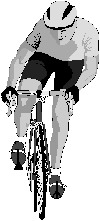 Pick up any book or magazine concerning the topic of physical fitness, losing weight, getting into shape, etc. and you'll see a common thread. They all tout the 3 corner stones of getting fit: 1-Diet, 2-Aerobics, and 3-Weight Training. Combining aerobics and strength programs with a sensible diet has proven to improve health, fitness and a better toned body. A proper diet reduces fat intake and inhibits the body from storing fats. Aerobics provides for a total body workout, which is important since fat loss is proportional. Weight training builds muscles, and muscles burn calories, even while you sleep. Here is how I used this information to get in shape for tournament fighting (and for beach bathing too!!).
Pick up any book or magazine concerning the topic of physical fitness, losing weight, getting into shape, etc. and you'll see a common thread. They all tout the 3 corner stones of getting fit: 1-Diet, 2-Aerobics, and 3-Weight Training. Combining aerobics and strength programs with a sensible diet has proven to improve health, fitness and a better toned body. A proper diet reduces fat intake and inhibits the body from storing fats. Aerobics provides for a total body workout, which is important since fat loss is proportional. Weight training builds muscles, and muscles burn calories, even while you sleep. Here is how I used this information to get in shape for tournament fighting (and for beach bathing too!!).
The Diet Plan
 In preparing for a tournament I needed a diet plan to reduce my bodyfat and still provide me with the energy needed for training. I learned that the secret to losing fat was to speed up my metabolism (the process by which the body breaks down food and releases energy). The first step was to change my eating habits. By eating 5 low-fat meals a day your body speeds up its metabolic rate to handle the steady intake of food and your blood sugar levels are controlled (more energy!) and you get protein throughout the day to aid in muscle recovery and growth. Also, by not going hungry your body stops storing fat. I eat my meals every 3 hours, and I only eat enough to tie me over to the next meal. Each meal is about 20% of the total calories for the day. I don't eat for what activity I just did, but rather for the activity I'm about to do. I eat a higher percentage of carbohydrates on workout days (for energy) and higher proteins on recovery days, since proteins aid in the recovery of muscle tissue. My total caloric intake is less than what my total calorie burn-off will be for that day. This means that I'm burning off more calories than I'm consuming. Remember: If you over eat you'll be over weight. If you under eat you'll under perform. Also, if you starve yourself your body will store fats in order to survive.
In preparing for a tournament I needed a diet plan to reduce my bodyfat and still provide me with the energy needed for training. I learned that the secret to losing fat was to speed up my metabolism (the process by which the body breaks down food and releases energy). The first step was to change my eating habits. By eating 5 low-fat meals a day your body speeds up its metabolic rate to handle the steady intake of food and your blood sugar levels are controlled (more energy!) and you get protein throughout the day to aid in muscle recovery and growth. Also, by not going hungry your body stops storing fat. I eat my meals every 3 hours, and I only eat enough to tie me over to the next meal. Each meal is about 20% of the total calories for the day. I don't eat for what activity I just did, but rather for the activity I'm about to do. I eat a higher percentage of carbohydrates on workout days (for energy) and higher proteins on recovery days, since proteins aid in the recovery of muscle tissue. My total caloric intake is less than what my total calorie burn-off will be for that day. This means that I'm burning off more calories than I'm consuming. Remember: If you over eat you'll be over weight. If you under eat you'll under perform. Also, if you starve yourself your body will store fats in order to survive.
On weekends I splurge, consuming more calories then I burn off, which is called 'zigzag' dieting. This readjust my basic metabolic rate, supports muscle growth and gives me a psychological lift. The meals are still low-fat, just more of the good stuff.
The amount of calories needed to maintain my workout routine is based on my age (38), body weight (150) and height (6'), and intensity of workout. I weight train 3 days a week for an hour, preceeded by 20 minutes on a StairMaster. On alternating days I go to TaeKwonDo class and run 3 to 5 miles. I need to comsume 1700 to 2100 calories a day during the week, and about 2400 a day on weekends. I have a base metalobic rate of about 1560 calories a day, therefore I need to burn off an additional 300 to 600 calories when I exercise in order to lose bodyfat. This is calculated as: calories consumed (1700) minus calories burned (1560+300=1860) equals total caloric loss (-160).
A sample meal plan for a weight training day is as follows:
Meal#
- 1 Banana, 2oz Frozen strawberries, 1 cup Skim milk, 1 scoop Protein powder
- 1.5 cups Oats, 4 egg whites, 1 Orange
- 2 slices Wheat bread, 2oz Sirloin (lean), 4 cups Lettuce, 1 Tomato
- 1 Sweet potato, 5oz Turkey breast, 1.5 cups Green beans
- 1 cup Lowfat yogurt, 1 Banana, 4.5 egg whites
Daily totals: Calories 1745; Proteins 162g(37%); Carbs 220g(50%); Fats 15g(8%)
A sample meal plan for a recovery day is as follows:
Meal#
- 1.5 pkgs Oats, 1.75 scoop Protein powder
- .50 Bagel, 1 Egg substitute, 1.25 cups Skim milk, 7oz frozen Strawberries
- 4oz Chicken breast, .75oz Pasta, .25 cup Skim milk, 1 apple
- 5oz Halibut, .50oz Whole wheat pasta, .50 cup Broccoli
- 3oz Mozarella cheese, 2 Light flour tortilla, 1oz Non-fat refried beans
Daily totals: Calories 1713; Proteins 192g(45%); Carbs 175g(41%); Fats 30g(16%)
Remember to keep your fat grams less than 20% of your total calories. To calculate this multiply fat grams by 9 (since 1 gram of fat equals 9 calories) to get the number of fat calories. Then divide that number into total calories. For example, if you consume 2000 calories a day and 24 grams of fat, multiply 24 x 9 = 216 calories from fat. Then divide 216/2000=.11. That's 11% of your calories coming from fat.
{Top}
Aerobics
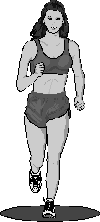 Since bodyfat is loss proportionally (over the entire body and not just in one spot at a time), it is important to include aerobic exercises into a fat reduction routine. Besides benifiting from the cardio-vascular aspects, aerobic activity uses the body's stored fats for fuel, and aerobics help speed up your metabolism. You must workout at the proper rate. As a rule of thumb you should still be able to carry on a conversation while involved in the activity. If you overtrain you'll burn muscle not fat. You should do your aerobic activity nonstop for 30 minutes at least 3 times a week. The more fat you have to lose the more often you'll have to do aerobics.
Since bodyfat is loss proportionally (over the entire body and not just in one spot at a time), it is important to include aerobic exercises into a fat reduction routine. Besides benifiting from the cardio-vascular aspects, aerobic activity uses the body's stored fats for fuel, and aerobics help speed up your metabolism. You must workout at the proper rate. As a rule of thumb you should still be able to carry on a conversation while involved in the activity. If you overtrain you'll burn muscle not fat. You should do your aerobic activity nonstop for 30 minutes at least 3 times a week. The more fat you have to lose the more often you'll have to do aerobics.
I was already running 3 to 5 miles a day 3 days a week. I then added 20 minutes of StairMaster or skimachine prior to my weight training, which is 3 days a week.
Aerobic type activities include jogging, cycling, swimming, aerobic classes, fast walking, rowing, roller blading, skating, ski machine, StairMaster, and treadmills. If you like, mix your activities. Do 10 minutes of jogging, 10 minutes of fast walking, and 10 minutes of StairMaster for your daily routine.
{Top}
Weight Training
 The third element in total body fitness is weight training. Remember "Big muscles burn calories". Weight training builds muscles, and when you build muscle you increase your metabolic rate since muscle is more biologically active than fat. It takes energy to sustain muscle, therefore big muscles require the constant burning of stored fats to maintain it's existance, even while you sleep!
The third element in total body fitness is weight training. Remember "Big muscles burn calories". Weight training builds muscles, and when you build muscle you increase your metabolic rate since muscle is more biologically active than fat. It takes energy to sustain muscle, therefore big muscles require the constant burning of stored fats to maintain it's existance, even while you sleep!
In planning a weight training routine you should plan to hit a different set of muscles each workout. I divide my workouts as follows:
- Monday: Biceps, Back, Abdominals.
- Wednesday: Chest, Triceps, Calves, Abdominals.
- Friday: Hamstrings, Quadriceps, Shoulders, Abdominals.
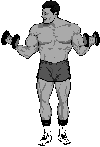 Do 2 or 3 exercises that work each muscle group. You can choose from this list:
Do 2 or 3 exercises that work each muscle group. You can choose from this list:
- Abdominals: Various Crunches, Situps, Side bends, Twists.
- Back: Lat pull-downs, One-arm dumbbell row, Seated cable pulls, Chin ups.
- Biceps: Alternate curls, Easy bar curls, Concentration curls.
- Calves: Seated calf raises, Standing calf raises.
- Chest: Flat bench press, Decline bench press, Dumbbell flys, Pec decs.
- Hamstrings: Leg curls.
- Quadriceps: Leg press, Squats, Leg extensions, Lunges.
- Shoulders: Front raises, Military press, Bent over laterals.
- Triceps: French press, Tricep push downs, Dips, Dumbbell kickbacks.
Do 3 sets of each exercise. The first set do 12 reps. The second set do 10 reps. The third set do 8 reps. Begin by testing your 1 rep maximum on each exercise. Then make each set in your workout a percentage of your max.
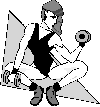
- For week 1 plan your sets at 60%, 65% and 70% of your max.
- For week 2 plan your sets at 65%, 70% and 75% of your max.
- For week 3 plan your sets at 70%, 75% and 80% of your max.
- For week 4 plan your sets at 75%, 80% and 85% of your max.
After your fourth week retest your 1 rep max and rework your sets.
For example, if your 1 rep max on bench press is 200 lbs, plan your first week sets: 12 reps at 120 lbs. 10 reps at 130 lbs. 8 reps at 140 lbs.
If you don't have access to weights you can still do strength training. Be creative, use items found around the home for weights. Gallon jugs filled with water are great for doing lunges. Do calf raises by placing the balls of your feet on the edge of a stair and lift up on your toes. Sit ups, Crunches, Push ups and Chin ups don't require weights to preform. See my page on Tournament Training for more non-weight strength training. Just do something!
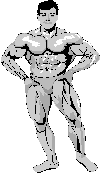 By combining these 3 corner stones of total body fitness I was able to lose over 20 lbs of body fat, and keep it off, going from 18% bodyfat to 9% in my first 4 months on this type plan. I became stronger and faster. I got to buy new clothes!!! After getting into shape I'm able to focus on my TaeKwon-Do training, and have fun doing so.
By combining these 3 corner stones of total body fitness I was able to lose over 20 lbs of body fat, and keep it off, going from 18% bodyfat to 9% in my first 4 months on this type plan. I became stronger and faster. I got to buy new clothes!!! After getting into shape I'm able to focus on my TaeKwon-Do training, and have fun doing so.
I work out at:

A Professional Health Club for Men and Women.
3908 Veterans Blvd.
Metairie, LA 70002
(504) 454-5855
When in Metairie stop by for a visit and ask for Allen Hebert (General Manager). Tell him Kicks sent you. Also, tell him to let me build him a website!!!
{Top}
Sources:
- Robert Kennedy's MuscleMAG, Abs Special, 1996.
- Alpha Sport, BodyCraft program
- Body Worry, Remar Sutton, Penguin Books, 1988
- Fit or Fat?, Covert Bailey, Houghton Mifflin Company, Boston, 1978
- My own personal experience!
Return to Kicks' Page.
{Top}